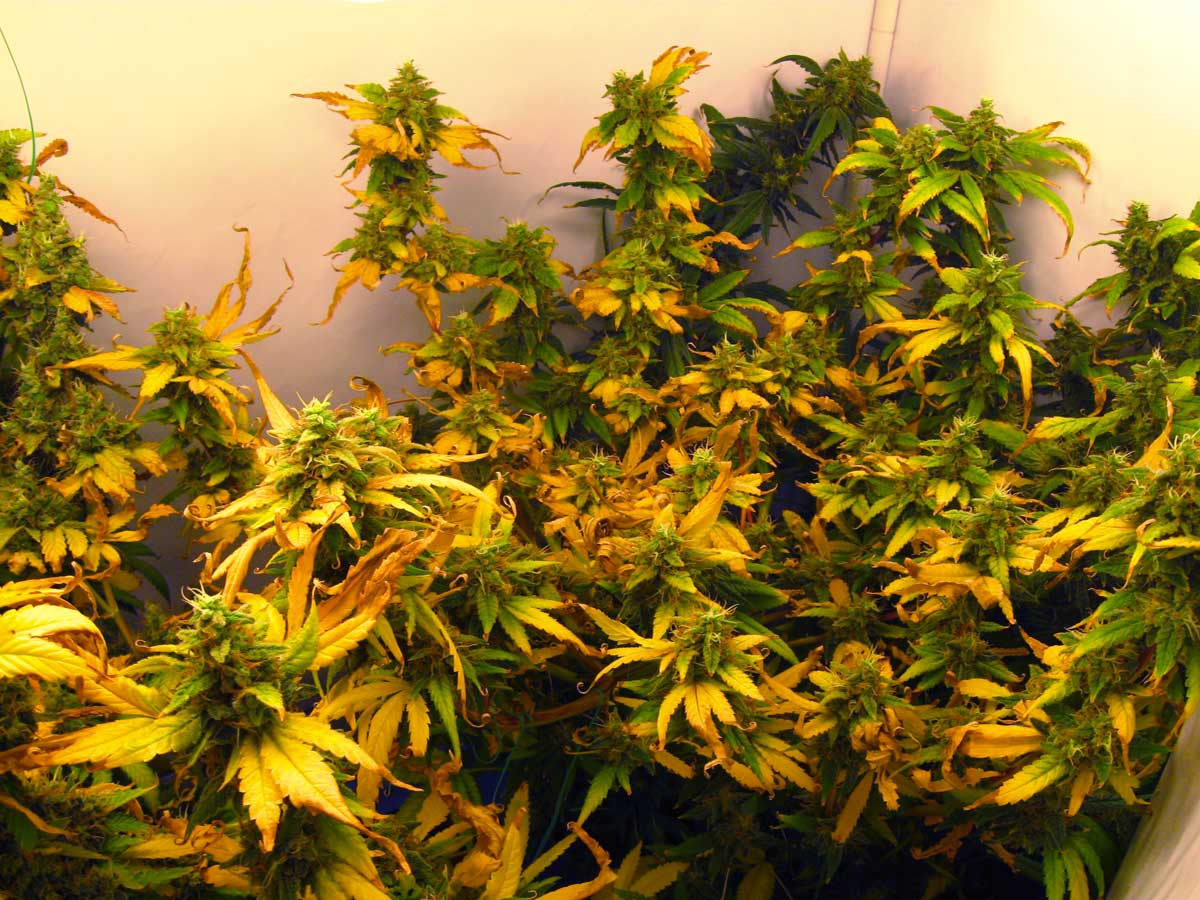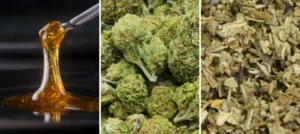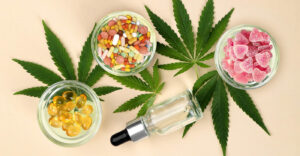Growing cannabis is both an art and a science, requiring careful attention to environmental conditions, nutrition, and light exposure. One of the most common issues growers face is light burn, a condition caused by excessive light intensity that can damage the plant’s leaves and hinder its growth. Light burn is often mistaken for nutrient deficiencies or heat stress, leading to misdiagnoses and ineffective treatments. In this guide, we will explore how to spot light burn early, understand its impact on plant health, and apply the best cannabis plant treatment strategies to prevent and recover from this issue.
Recognizing Light Burn in Cannabis Plants
Light burn typically manifests in the uppermost leaves of the cannabis plant, where they receive the most intense light. The first signs include yellowing of leaf tips, progressing to a bleached or white appearance. Unlike nutrient deficiencies, which usually start from the bottom leaves upward, light burn is most severe on the top canopy. Leaves may curl upwards, resembling heat stress, but the key difference is that heat stress also causes wilting, whereas light burn does not immediately lead to droopy leaves.
A 2023 study on indoor cannabis cultivation found that plants exposed to light intensities above 900 PPFD (Photosynthetic Photon Flux Density) for prolonged periods exhibited visible light burn symptoms within 10 days. The ideal PPFD range for cannabis during the vegetative stage is 400-600 PPFD, while during flowering, it can increase to 600-900 PPFD. If these levels are exceeded without proper adjustments, plants may suffer damage.
Causes of Light Burn in Cannabis
Light burn occurs when a cannabis plant is exposed to an excess of light intensity without adequate adjustment. Common causes include:
- Incorrect LED Placement: Many indoor growers use high-intensity LED grow lights, but placing them too close to the canopy can overwhelm the plant.
- Excessive Light Hours: While cannabis thrives in long daylight cycles, exceeding the recommended photoperiod (18 hours for vegetative and 12 hours for flowering) can stress the plant.
- Overpowering Light Spectrum: Some grow lights emit excessive blue and UV light, which can contribute to light burn, especially when not balanced with red and far-red wavelengths.
- Lack of Light Adjustment: As cannabis plants grow taller, the distance between the light source and the canopy decreases, increasing light intensity and risk of burn.
A cannabis plant care study conducted by Michigan State University demonstrated that lowering light intensity by 20% after spotting the first symptoms significantly reduced damage and helped plants recover faster.
Preventing Light Burn in Cannabis Plants
Prevention is the best method of cannabis plant treatment for light burn. By implementing the following strategies, growers can maintain optimal light conditions:
- Adjust Light Distance: Different types of grow lights require specific distances from the plant canopy. As a general guideline:
- Fluorescent Lights (CFLs): 6-12 inches
- LED Grow Lights: 12-24 inches
- High-Pressure Sodium (HPS) Lights: 18-30 inches
Keeping a safe distance prevents excessive intensity while ensuring adequate light penetration.
- Monitor PPFD Levels: Using a PAR meter to measure PPFD ensures that light intensity stays within the safe range. For vegetative growth, 400-600 PPFD is ideal, while flowering requires 600-900 PPFD.
- Implement Light Cycling: Following the correct photoperiod prevents stress-related damage. The recommended schedule is 18/6 (18 hours light, 6 hours darkness) for vegetative growth and 12/12 for flowering.
- Gradual Light Acclimation: When transitioning seedlings or clones to a high-intensity environment, increase light exposure gradually rather than exposing them to full intensity immediately.
- Use Light-Spectrum Adjustments: Some LED grow lights allow spectrum adjustments. Reducing UV and blue light output slightly can help prevent light stress in sensitive plants.
A research study published in the Journal of Plant Physiology found that cannabis plants grown under balanced full-spectrum lighting exhibited 30% fewer stress markers than those exposed to excessive blue or UV light.
Treating Light Burn in Cannabis Plants
If your cannabis plant has already suffered from light burn, immediate intervention is necessary to prevent further damage and allow for recovery. Here’s how to effectively apply cannabis plant treatment for light burn:
- Reduce Light Intensity: The first step is to lower the light’s intensity or increase its distance from the canopy. This prevents further stress and allows damaged leaves to recover.
- Trim Severely Burnt Leaves: Leaves that are completely bleached or necrotic will not recover and should be carefully removed. This helps the plant redirect energy to healthier growth.
- Provide Optimal Nutrients: Although light burn is not a nutrient issue, plants suffering from it may require additional support. Supplementing with a balanced N-P-K fertilizer (Nitrogen-Phosphorus-Potassium) and micronutrients like calcium and magnesium can help boost recovery.
- Increase Humidity: Raising humidity levels to 50-60% can reduce stress on damaged leaves, as light burn often causes excessive transpiration and dehydration.
- Lower Temperature: Keeping grow room temperatures between 72-78°F (22-26°C) prevents additional heat stress that can worsen light burn symptoms.
- Introduce CO₂ Enrichment: Studies show that cannabis plants grown under CO₂ levels of 1200-1500 ppm can tolerate slightly higher light intensities without stress. Adding controlled CO₂ can aid in photosynthesis and plant recovery.
A report by the Cannabis Science and Technology Journal found that growers who reduced light intensity by 25% and increased CO₂ concentration by 30% saw a 15% faster recovery rate in plants affected by light burn.
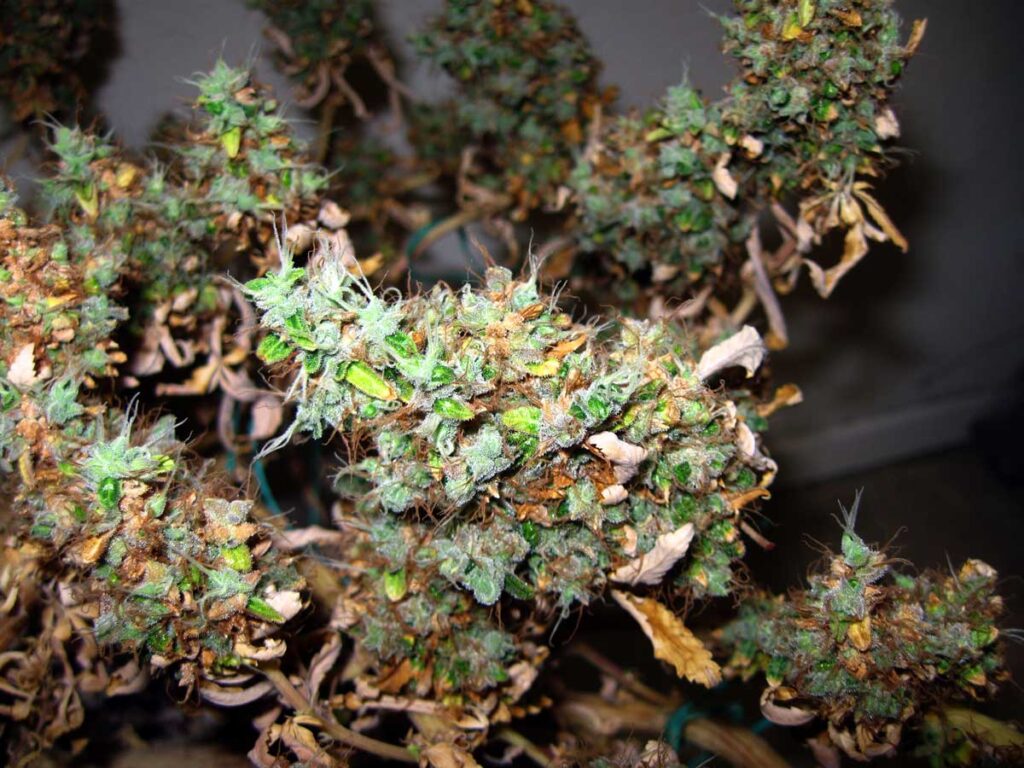
Long-Term Cannabis Plant Care to Avoid Light Burn
Preventing light burn requires continuous cannabis plant care and environmental monitoring. Implementing the following practices ensures plants remain healthy and productive throughout their growth cycle:
- Regularly Adjust Light Placement: As plants grow taller, maintain a proper distance between the canopy and the light source to prevent excessive intensity.
- Monitor Environmental Factors: Keeping track of humidity, temperature, and CO₂ levels ensures plants receive optimal conditions for growth.
- Use Light Meters and PAR Sensors: These tools provide accurate light intensity readings, helping to adjust settings as needed.
- Choose High-Quality Grow Lights: Investing in full-spectrum LED grow lights with adjustable intensity and spectrum settings can significantly reduce the risk of light burn.
- Rotate Plants if Necessary: For those using stationary lighting setups, rotating plants periodically ensures even light distribution.
A study published in the International Journal of Horticulture found that growers who adjusted light placement and intensity every 5-7 days experienced 40% fewer cases of light burn compared to those who left lighting static.
Conclusion
Light burn is a common yet preventable issue in cannabis cultivation. Understanding its symptoms, causes, and treatment methods ensures that growers can take the right steps to protect their plants. By maintaining proper cannabis plant care, adjusting light placement, and monitoring environmental conditions, cannabis cultivators can optimize plant health and maximize yields.
Implementing these strategies not only helps in cannabis plant treatment for light burn but also enhances overall plant resilience, leading to stronger and more productive harvests. Whether you are a beginner or an experienced grower, paying close attention to light exposure will ensure your cannabis plants thrive without suffering from unnecessary stress.
Prevent light burn and maximize your cannabis yield with NanoHempTechLabs‘ advanced grow technology. Our cutting-edge LED lighting systems, nutrient solutions, and environmental monitoring tools ensure optimal cannabis plant care for healthier, more resilient crops. Say goodbye to damaged leaves and poor yields—our scientifically backed products help you achieve stronger, more productive harvests with ease. Ready to take your grow operation to the next level? Schedule a call today with our experts and discover wholesale pricing on industry-leading cannabis cultivation solutions. Let’s grow success together!
Reference:
- Holweg, M. (2024). The role of red and white light in optimizing growth and accumulation of plant specialized metabolites at two light intensities in medical cannabis (cannabis sativa l.). Frontiers in Plant Science, 15. https://doi.org/10.3389/fpls.2024.1393803
- Kang, Y., Wu, Q., Qin, J., Zhong, M., Yang, X., & Chai, X. (2022). High relative humidity improves leaf burn resistance in flowering chinese cabbage seedlings cultured in a closed plant factory. Peerj, 10, e14325. https://doi.org/10.7717/peerj.14325
- Llewellyn, D., Golem, S., Foley, E., Dinka, S., Jones, A., & Zheng, Y. (2022). Indoor grown cannabis yield increased proportionally with light intensity, but ultraviolet radiation did not affect yield or cannabinoid content. Frontiers in Plant Science, 13. https://doi.org/10.3389/fpls.2022.974018
